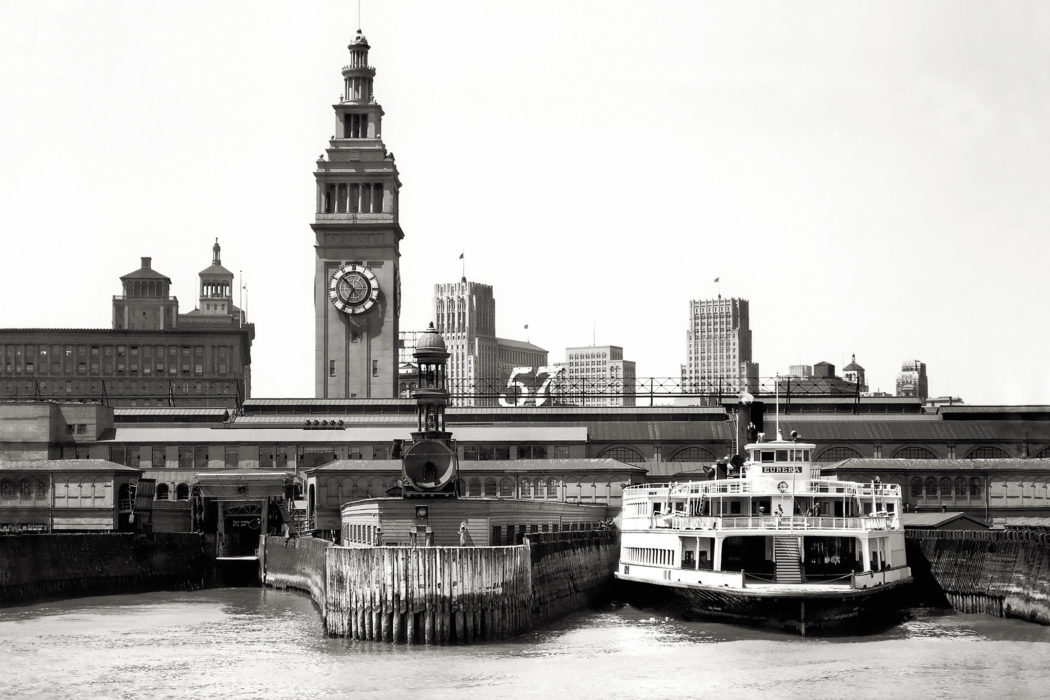NOT UNTIL 1930 WOULD they build bridges to span the gulf between the eastern shore of San Francisco Bay and the resurrected city that gave it its name. The iron ribbons therefore terminated in Oakland, emptying passengers who had chugged west across the continent into ferry boats for the final ply across the water to their docks. From there they would walk along the wharf, and down a long corridor, and step out onto The Embarcadero to be met.
“Slowly the hours seemed to pass,” Dr. Frederick D’Evelyn wrote many years later. “Eventide came, and with it, disconcerting reports of delay. . . . Telegrams to railway headquarters brought the discomforting news that [the] schedule time had been abandoned, and no time of arrival was hazarded.”
‘Abdu’l-Bahá had departed Salt Lake City at 2:50 p.m. on October 1. After crossing Great Salt Lake he and his party had missed their train connection in Montello, Nevada, causing a delay of many hours. Now it was the middle of the night on October 2. In San Francisco, at 1815 California Street, near Lafayette Park, Dr. D’Evelyn waited impatiently for the visitors to arrive. Just after midnight he received a telegram, telling the friends who were with him not to wait. “Send only one friend to depot,” it read.

“Securing two taxis we left for the Ferry,” he wrote. They drove east down the dim sleeping streets toward the terminal, which lay along the waterfront at the northeastern end of Market Street. “Arriving there we ascertained the sections may possibly arrive about 1:30 a.m. The night deepened, the Ferry was deserted. The lights of the city waned to a minimum. The ever dimly lighted corridor became still darker and still more gloomy and lonely.”
Finally, at 1:40 a.m. a siren acknowledged the approach of the ferry. “Some minutes later,” D’Evelyn continues, “the slide at the end of the corridor was upraised. A few, very few emerged. They reached the street, still no evidence of the Master.”
“What, if he was not there?” Other than D’Evelyn and the two taxi drivers he had brought with him, only a night patrol man and a porter in a red cap occupied the corridor. He asked the porter if all the passengers had disembarked. The porter said no. “Still hoping, we ventured to enquire — were there any unusual looking people on board?”
“Yes, he replied, there is a very old gentleman with strange dress and several other strangers with Him.”
“Once again we hoped and centred our gaze upon the far end of the corridor. Some minutes later Abdul Baha appeared, walking slowly, calmly, majestically, followed by his secretaries.”
‘Abdu’l-Bahá had departed Buffalo on his train trip west at 5:35 a.m. on September 12. Twenty-one long days later, “in the weird moments between two and three in the morning,” D’Evelyn noted, “the white turban of Abdul-Baha at last issued from the long exit at the ferry . . . and the welcome of his eyes eliminated all the weary hours of hope delayed.”
“Forgetful of boundary lines,” Frederick D’Evelyn recalled, “we advanced to meet him. He drew near more rapidly and with outstretched arms he embraced us, uttering a salutation followed by the English words — ‘Very good; very Good.’”






